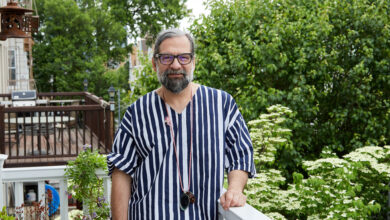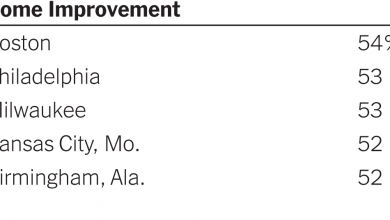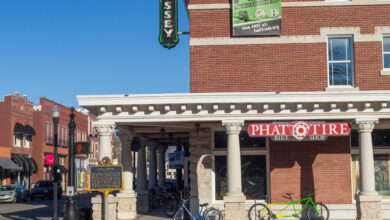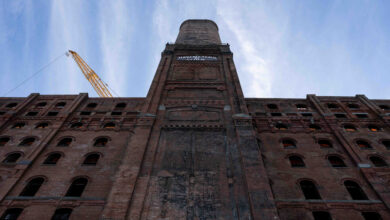Sleeping in the Outdoors – The New York Times
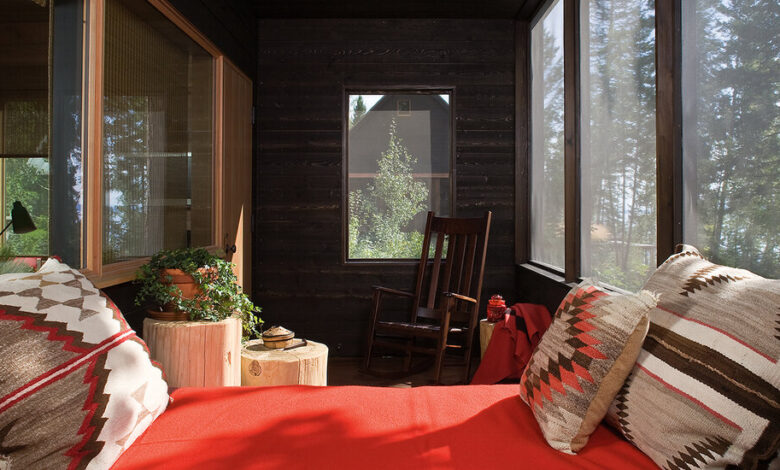
When the interior designer Greg Baudoin and his partner, Greg Campbell, a floral designer, purchased and renovated a lake house in Snow Lake Shores, Miss., they expected to use it as a weekend retreat.
Covid changed that, allowing them to break away from their primary residence in Memphis, which is about an hour away, and spend the bulk of their time at the two-bedroom cabin with a 16-foot by 16-foot screened-in sleeping porch that they use as their main bedroom.
“We added casement windows with screens so that it could be a four-season porch and we could enjoy it all year long,” said Mr. Baudoin, 57. They insulated the area as well, but sometimes rely on heat from the living room’s wood burning stove for extra warmth when temperatures dip.
A spartan sleeping porch this is not. A vintage picnic table stands at the foot of the bed and a family heirloom rocking chair is in the corner of the room, which is filled with a mix of American and French antiques.
There is an entablature of shingles resting on the board and batten siding, forming the interior walls. The ceiling is beadboard painted a traditional sky blue. “The color is a tradition in the South, mostly Deep South where I am from, and has roots in early Creole culture,” Mr. Baudoin said.
The bed, which was custom designed by Mr. Baudoin and upholstered in fabric by Champalimaud of France, has a headboard and footboard of the same height, so at different times of the year they can flip the direction of their sleep positions to catch the changing seasonal views. “It’s like a daybed,” Mr. Baudoin said. “We call it the ‘everybody wins bed’ because no matter which direction you’re facing it’s a good view any time of year.”
Adopting fresh air spaces for rest has proven health benefits, studies show it can boost the immune system and reset the body’s circadian rhythm, which can be easily disrupted by stress and the blue light emitted by electronics with screens.
“One of the treatments which may restore our baseline circadian rhythm is early morning bright light such as natural sunlight which occurs with outdoor sleeping or camping,” said Dr. Richard Friedenheim, the medical director at the Sleep Disorders Center for Abington Hospital — Jefferson Health in Abington, Pa.
Designers extol the benefits of biophilic design, too. “Exterior protected rooms engage all of our senses,” said Arthur Andersson of Andersson/Wise, an architecture and design studio in Austin, Texas, which has created similar spaces for residential clients across the country. “A sleeping porch oriented to take in prevailing breezes, the path of the sun and the sounds of nature has great power to restore and reinvigorate.”
To Michelle Fries, an interior designer based in Minneapolis who specializes in styling these intimate areas, sleeping porches provide a special sense of nostalgia for many, and their ability to harmonize with nature make them the unsung heroes of rooms. “In the Land of 10,000 Lakes, it’s one way to make the most of summer rainstorms,” she said.
Before the invention of air-conditioning, sleeping porches were ubiquitous, especially in the South and the West. “A sleeping porch is not that different from a sunroom or an enclosed porch,” said Richard Bubnowski, an architect in Point Pleasant Beach, N.J. The most important thing in the Northeast is its orientation to the sun, he said. “If you’re planning on using it most of the year, make sure there’s sun exposure so there’s passive heating coming in over winter, and in the dead of summer you might want lots of trees around it for privacy and shading.”
In Gloucester, Mass., a rustic pagoda-like pavilion constructed from reclaimed barn wood holds court under a canopy of native black cherry and poplar trees in the backyard of the landscape designer Hilarie Holdsworth.
Every spring, Ms. Holdsworth, 57, officially opens the 10-foot-by-12-foot space, which was built in 2013, and arranges a futon and mountains of pillows for warm weather sleepouts. “We jokingly call it the pillow palace,” Ms. Holdsworth said. “It’s a great place to sleep when it’s boiling hot.”
The sylvan screened-in hideaway cost approximately $15,000 to build and gets used from mid-May through October. Its functionality is an asset, said Ms. Holdsworth, but its presence, just like a pergola or stonework, also creates a wonderful focal point in the garden. “It provides a sculptural element in the gardens. You can’t just rely on plants all the time.”
During the pandemic, cavernous tents pitched in the yard also have been a welcome escape from familiar rooms, and a reason to draw families together.
Betsy and Joe Parker of Des Moines, Iowa, had been mulling over the idea of a gazebo in their backyard, but when Covid arrived, they concentrated on creating an additional living space steps away from their three-bedroom home.
At first, they considered constructing a tiny house out of a grain bin, but the thought of hot Iowa summers changed their minds. “We decided that we would find little comfort in a building made out of steel with no ventilation,” said Ms. Parker, 40, a manager for an integrated marketing agency serving nonprofits.
An internet search led them to a $700, 16.5 foot diameter four-season tent with a built-in ventilation pocket for the pipe of a small wood burning stove, which they purchased for about $200 to heat the tent.
They moved in starting last October, spending about two nights a week outdoors until the seasonal chill eclipsed the stove’s capabilities. But as soon as March rolled around, they returned to sleeping in their outdoor bedroom. “Sleeping outside has been a wonderful addition to our lives that we didn’t realize we were missing,” Ms. Parker said.
To create a level surface area, they built a crushed rock foundation, which they may utilize in the future as a patio if they decide to remove the tent. The surrounding landscaping has also received a makeover this past year, with new lighting, bird feeders and hammocks, which cost about $1,150. Now, they’re considering adding a small pond to their backyard “oasis.”
The inside of the tent is decorated with a full bed, chairs, a TV and portable record player, which has replaced the stove for the summer. A Porta Potty was added to the corner of the property for convenience, and comes in useful for middle of the night bathroom runs or the occasional backyard social gathering.
Mr. Parker, who is 45 and an operations manager at a financial company, said the benefits of sleeping outdoors never occurred to him until he started to notice big changes in how well he was resting. “I’m not a morning person. But with the light coming on slowly and progressively and bird noises coming on naturally — I can’t get this kind of audio visual wake-up anywhere else.”
David Hertz, a California architect who specializes in the design and construction of sustainable and restorative places, has been a longtime loyalist to the tenets of indoor-outdoor living. Last year, his focus turned to a personal project: outfitting a temporary cluster of tents on his 99-acre property located in the Santa Monica mountains of Malibu, Calif.
The encampment, which Mr. Hertz and his wife, Laura Doss-Hertz, dubbed “Farside,” consists of Lotus Belle canvas tents in assorted sizes, whose playful shapes emulate Hershey’s Kisses.
A quick fix for those seeking Instagram-ready glamping rooms for backyard retreats, the canvas domiciles range in size from cozy to colossal — the smallest can fit a queen-size bed, the largest features 700-square-feet of interior space. Prices start at $1,250 and go up to $8,500.
The tents were staged specifically for extended family and friends seeking to escape into nature in the pandemic year, said Mr. Hertz, 60, whose property borders a national recreation area, which is home to an ecologically diverse array of plants and animals, including nearly 400 species of birds.
Mr. Hertz and his wife, who is a photographer, often joined guests at the camp, which sleeps up to eight people, and is half a mile from the 1920s Adirondack-style hunting lodge they primarily call home. Within Farside, two stretch tents are combined to create a large outdoor living space, decked out with Turkish rugs, Moroccan pillows, end tables and lanterns.
Electricity is no problem for the campers, who plug devices into mobile solar-powered battery chargers, which also supply energy to the tent’s light sources. Heated outdoor showers and self-contained Porta Potties are additional amenities for guests.
Beyond the tent fabric’s alluring translucency, Mr. Hertz appreciates the transitory nature and portability of tents — if you have the space, you can move your location and your views.
Their favorite campouts were on nights with full moons. “There’s something about the intimacy of the tent, like a boat gives you a sense of a shelter, it feels like a cocoon in a way, and that’s really welcoming.”
For weekly email updates on residential real estate news, sign up here. Follow us on Twitter: @nytrealestate.


